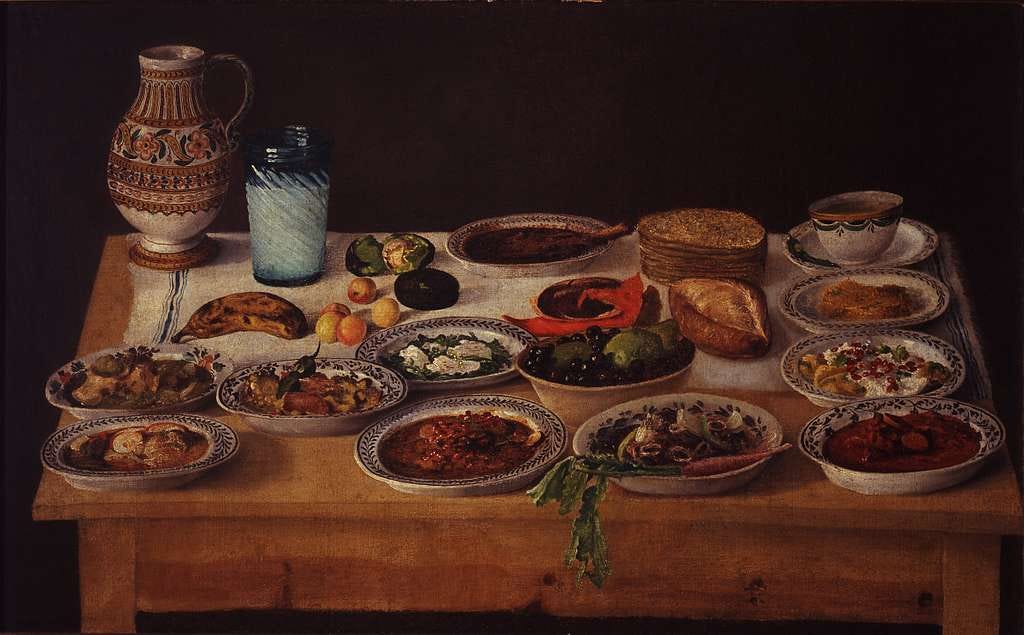Welcome to Just Two Things, which I try to publish two or three times a week. Some links may also appear on my blog from time to time. Links to the main articles are in cross-heads as well as the story. A reminder that if you don’t see Just Two Things in your inbox, it might have been routed to your spam filter. Comments are open. And: have a good weekend.
#1: The human right to food
The food academic Marion Nestle does a short daily blog monitoring research and other developments in the food sector, and the other day she covered Mexico’s new law on Sustainable and Affordable Food. It came into force in April.
She had noticed coverage in the British medical journal The Lancet, which summarised the new law this way:
Mexico’s new General Law on Adequate and Sustainable Nutrition (Ley general de Alimentación Adecuada y Sostenible) is a substantial step towards transforming food systems to address NCDs and promote environmental sustainability… It enshrines the human right to food…It prioritises health, environmental stewardship, water access, children’s health, enhanced food supply and distribution, the promotion of nutritious food, reduced food loss and waste, food provision in crisis situations, and social participation in food strategies.
(‘Puebla Kitchen’. Artist and date unknown. Public domain, via Wikimedia Commons)
That sounds like quite a big deal, and I have written here before about the fact that treating the food sector as if it is a commercial market sector generates huge and increasing external costs. As a reminder, here’s an extract from one of those Just Two Things posts:
We’re currently producing enough to feed the world’s population, but close to one-in-ten people globally are under-nourished, and this number has been increasing again after a long period of decline. 770 million—also close to one-in-ten of the world population—are obese. The FAO has recently estimated that the external health costs of the food system are at least $10 trillion annually.
Of course, a hundred dollars feels real, but $10 trillion is just a statistic, as Stalin nearly said, so to put that in context, it’s around 10% of the global economy (currently estimated at $100-105 trillion). As external costs go, 10% of the economy is a huge figure.
The external costs of the food sector were one of the reasons that the report that I worked on the the UK charity Impact on Urban Health on Urban Food Futures included a policy recommendation that healthy, accessible, affordable food should be a right for all.
But back to Mexico. Obviously the new law is in Spanish, but fortunately the USDA Foreign Food Service has produced a summary translation.1 Marion Nestle pulls out some of the Articles of the new law in her post, and I’m going to mention some of those here (the cross-headings are mine):
Food as a source of cultural and biodiversity:
Article 4 describes that the right to food includes biocultural wealth, emphasizing gastronomic diversity and agrobiodiversity, as well as the link between food and culture.
Free or affordable food:
Article 16 describes that students enrolled in elementary schools have the right to receive adequate food in school establishments, free of charge or at affordable prices for their families, according to their conditions of vulnerability and considering the economic situation of the geographical area in which they are located.
More generally,
Government policies must ensure proper nutrition education and government subsidies of culturally, ecologically, economically, and socially relevant local foods at schools and other social institutions – at no cost.
Transparency about food production:
Article 21 involves mandatory warning label requirements for products that contain GE ingredients.
Article 22 mandates that food producers and distributors provide information requested by any individual regarding the inputs or processes used to generate their products or services.
Public procurement rules:
Article 28 gives preference to state purchases of food from local or regional producers of small and medium scale, including farmers in home or backyard gardens.
Article 37 describes that the government, within the scope of its power, will incorporate at least 30 percent of purchases of food and primary supplies directly from small and medium-scale producers within budgetary limits.
Shaping national food policy:
Article 44 states that the guiding principles of the national food policies, programs, and actions which guide food production much include assurance of self-sufficiency, biodiversity, and agrobiodiversity in production.
Articles 56 through 63 describe the powers of SINSAMAC, an agency that will develop national food policy.
I thought it would be worth going to look at The Lancet’s assessment in a bit more detail (free but registration required.)
The first thing to say is that Mexico already has a constitutional right to nutritious, sufficient, and quality food, in Article 4 of the Constitution, and therefore the new law is trying to give legislative effect to this. The second is that the Act positions Mexico as a leader in this legislative area, in that it represents an integrated approach rather than piecemeal bits of law addressing specific food issues. And the third is that Mexico has a big food-related health problem:
Mexico faces high rates of obesity and diet-related NCDs [non-communicable diseases], including type 2 diabetes. In 2022, 36·9% of adults in Mexico had obesity, compared with 16% of adults worldwide. In 2022, diabetes affected 18·3% of Mexico's adult population, compared with 10·5% of the global adult population... Although initially more prevalent among the affluent, these NCDs now affect people living at all socioeconomic levels, being more prevalent among low-income populations and exacerbating inequalities.
One of the elements the authors like about the Act is that it uses existing governance structures, rather than creating new institutions or adding new elements of bureaucracy. It also looks across the complete food system (previous policies mostly addressed food insecurity). However, this scope means that new policies and approaches will be needed (there are examples elsewhere that Mexico can draw on here.)
The scale of all of this also makes resistance more likely. Elsewhere, the food sector has been successful at watering down legislation intended to limit the external impacts of its activities. The authors note that:
The law must be protected from undue commercial determinants. Powerful individuals and organisations in the food industry can both benefit and harm human health and the environment. Although the law promotes multistakeholder engagement, it also includes safeguards against undue influence, which must be properly regulated and monitored.
In summary, they say that this is a big step forwards: it is comprehensive and also set out as a rights-based framework. It gives other countries a model to learn from.
#2: 21st century futures
There’s an interesting interview at Paul Raven’s blog, Worldbuilding Agency, with the science fiction writer and futurist Karl Schroeder. It’s long and discursive, so here I’m going to focus on only one element of it: the difference between 20th century and 21st century ideas about the future, which Karl Schroeder has been developing in his own newsletter, Unapocalyptic over the last few months.
(KarI Schroeder. Image: www.kschroeder.com)
Paul Raven is also a science fiction writer and futurist, so this is more of a conversation than an interview. (Disclosure: Paul is a friend and a sometimes colleague.)
PGR: [H]ow are you defining a twenty-first century idea as distinct from a twentieth century one? And the really obvious answer here is to say "well, Paul, it's an idea that emerges after a particular date…" But I get the feeling there's something... that's the quantitative answer, but there's a qualitative thing that you're getting at there as well...
KS: A good example would be enactivism or enaction, which is a theory in cognitive science that strongly opposes representationalism and the idea of information processing as being what really goes on in the brains of living organisms; in other words, the mind-as-software paradigm is wrong.
This idea comes from a book called The Embodied Mind, written by Francisco Varela, Evan Thompson and Eleanor Rosch, and published in 1992, although the roots go back much further:
KS: [T]he specific idea, which was only really developed after 2000, is that the mind extends into the environment and the physical body of an organism, and they act together to create perception and cognition. This is entirely different from the brain in a box idea: that you have perception that brings information in, you process that information in the brain, and then you act. Instead, here the idea is that you perceive by acting...
This is an idea with deep roots, but it is also a very new paradigm, in and of itself. And most of the, the twenty-first century ideas that I'm talking about have this form: new interpretations of quantum mechanics, for instance, that are very clearly of this century.
He uses Elon Musk as an interesting example of someone whose ideas are those of the twentieth century.
[Musk] has decided that the problems he's going to solve are the problems that were defined in the science fiction of the 1970s and 80s and to some degree the 90s. So he is creating rocket ships, he's creating electric cars, he's creating robots, he's creating neural interfaces—all of the imagined wonders from the 1900s. What he is not doing is asking himself, what are the wonders of the twenty-first century?... Electric cars are great, but actually e-bikes have had a much bigger impact on the environment than electric cars. We require a new kind of thinking that's appropriate to the age—and that's not engineering thinking.
In a post on his blog, Karl Schroeder has written about framing these older ideas as being “of the 1900s” rather than “20th century”:
‘The 20th century’ still feels continuous to now (especially if you grew up there). The 1900s, though, like the 1800s, are a different story; they’re history—they’re the part of the pre-anthropocenic age... This is like wondering how much current culture and thought is based on the ideas of the 1800s, or the 1700s; it’s a different mental operation than imagining us as present on a timeline that seamlessly passes back into the 20th century.
Going back to the interview Karl gives an example of this—the gap between the way science fiction imagines the futures of technology and it imagines all of the social values that might emerge at the same time:
KS: I completely fall out of faith with a novel set in the future that imagines all kinds of fantastic changes due to nanotechnology and artificial intelligence and space travel and biological or genetic alterations, and yet fails to imagine that we might have different ways of governing ourselves. The monarch, the tyrant, the autocrat, you know, democratic processes, parliaments and so forth: they show up again and again in futures that are otherwise presenting themselves as, radically different and new. So when I talk about experimenting with ideas that are entirely of this century, well, that's one of them. What would it mean to make a break with the past regarding governance?
There’s an important futures point in here: people often construct scenarios in which all sorts of things change but our current values have simply been projected into the future. But values change on generational timescales. There’s an example of how this might happen in the interview.
In his novel Stealing Worlds, for example, Schroeder explored a different form of political economy, in which the means of production, rather than being owned by either capitalists or workers, are owned by themselves.
(Image: www.kschroeder.com)
This obviously has implications for worldbuilding, which is at the heart of this conversation. From a futures perspective, we do worldbuilding a lot, without often thinking enough about what it means—every scenario, every speculative fiction, has a world sitting within it. In some ways the requirement that a scenario is ‘coherent’ helps here, but it usually means coherent at a systems level, and usually in a space where political economy interacts with the social shaping of technology.
(The word ‘plausible’ is sometimes used in this context, but there are a dozen reasons why the notion of plausibility is unhelpful, but mostly that it closes down the imagination.)
Because Schroeder and Raven are writers, they end up talking about narrative, and there’s a strong implication in the conversation that a good narrative, with characters, can do the work of making a future coherent for the reader:
KS: Worldbuilding is a word that has a history and that for me was associated specifically with science fiction and fantasy for most of my career. The the term really has traction when we talk about J. R. R. Tolkien, because in his case the novels that he wrote were really to support the worldbuilding exercise that was his hobby... But the term was cheerfully and happily hijacked in the 2000s by foresight practitioners who began at that point to wonder if the presentation of ideas through narrative was not just a reporting mechanism, but in fact could be a form of analysis in its own right... So for people who do foresight, the idea that, oh, okay, testing my ideas to destruction by putting them in a story and seeing whether they make sense, suddenly this becomes methodologically free—an acceptable and, even extremely useful way to approach exploring ideas.
That leads quite quickly to design futures and speculative futures.
You can go further with this. Emily Spiers’ narrative futures method uses narrative methods to open up the imagination completely. But you need a certain sort of client, and a certain sort of question, to decide to use this.
j2t#596
If you are enjoying Just Two Things, please do send it on to a friend or colleague.
When I say ‘summary’, it comes with this disclaimer: ‘This summary is based on a cursory review of the Law approved and therefore should not, under any circumstances, be viewed as a definitive reading of the regulation in question.’





